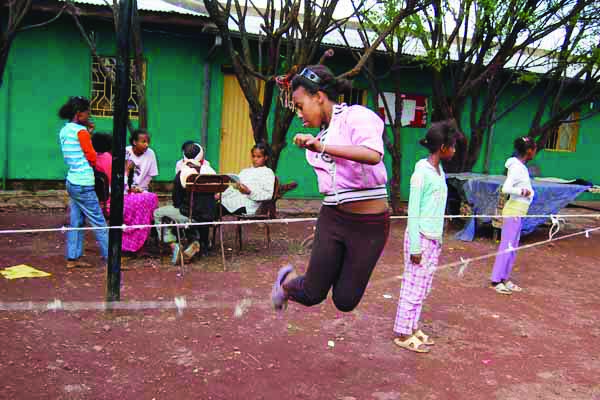These days, children have a whole new understanding of what fun and games are. It’s all about about online games, from Playstations to Nintendos, watching too much TV and spending hours on their iPads.
Youngsters nowadays spend more time worrying about having the latest smart phone and brand name clothing than they do simply playing outside in the fresh air and sunshine. Even time honoured traditions like going to the farm or village over school holidays are dying out because they’re deemed embarrasing and children are labelled as gwerries or plaasjapies.
Gone are the days when children congregated outdoors, ran around barefoot, enjoyed farm life and their favourite games in the street. Back in the day, youngsters explored the outdoors uninhibited by gizmos and gadgets, simply having a great time in nature.
Those were the days when the only phone one had access to was the phone booth. By the way, nobody knew who to call because everyone lived around the corner.
After school hours were spent playing with friends, talking and putting together anything that would be useful as a game. Group sports were a big thing. Everyone was involved in the creative aspect of putting games together.
Apart from it being fun, it also helped build fundamental skills, from social interaction to physical hand and eye co-ordination and even basic maths and strategic thinking.
Unlike nowadays, in the past toys and games were often homemade rather than shop bought. For example, boys played with hoops from the rims of tyres. Girls skipped with ropes or played with homemade dolls.
Today, many of these types of things are almost unheard of in modern society, making way for far more technologically advanced youth. And with this fast paced technical development, many treasured games are lost and forgotten.
The Weekender decided to reminisce on the games we enjoyed during our childhoods. Can you remember them?
//hu in Damara also known as Owela in Oshiwambo (played throughout Africa)
This is believed to be the oldest game in the world. It was played in as many countries on the continent as there are variations of it. So if you don’t recognise the name, it’s probably because it’s been called a lot of names.
How does it work? First you need a board, or you can dig holes in the ground. The holes are arranged in either two or four rows. Small stones or seeds were used in earlier days; today, using marbles is common. The aim of the game is to literally move your stones around so that you can capture more than your opponent. It’s fun, but strategic, much like chess.
Chukulu in Damara and Ndota in Oshiwambo
There are a few versions of this game, all which need at least three players to make it fun. Two or more players sit in a circle around a wooden bowl or a hole in the ground filled with about 20 small stones or marbles.
The first player picks up a stone and throws it up in the air. It’s all about quick fingers. Before it drops down, the player tries to pick up as many other stones in the bowl as he or she can. Once all players have had a chance, the stones are counted and the one who collects the most is the winner.
Uma-dowa (also played across Africa)
This game starts from the ankle, working all the way up to the neck. It’s mostly played by girls. All you need is wool thread or a rope. The rope is fitted around the two players standing opposite each other. A third player jumps in the middle.
The two players on each end stand very still while the third player jumps, which is easy for the jumper.The game then gradually progresses as the rope is lifted higher and higher. A fourth player can also be introduced, which makes it more challenging.
Skululu
This game can be played by more then two teams, equal in numbers. A field is drawn on the ground and a ball is used. The starting team lines up and attempts to kick the ball as far as possible and the opposition team tries to catch that ball. If the ball enters any of the neighbours yards, that player has ended his or her round. It’s almost like cricket, only the players kick the ball.
Other games that made childhood memorable
* Block-block (also known as hide and seek) and ‘Ou wolf ou wolf hoe laat is dit?’ This game was played at night. It’s like play hunting with a group of children, one in the group plays the wolf, then the others sing and ask, ‘wolf, wolf’, what is the time? the wolf replies and says ‘it’s 8 o’clock’.
The children can repeat the question over and over until the wolf says: ‘dis tyd’ (it’s time) and chases every one. The child to be caught for ‘dinner’ is the next one to play the wolf. This used to be a very exciting game because you never knew exactly when the ‘wolf’ would decide to go ‘hunting’.
*Amagoes,vangbal, ‘gees in die glas kom uit’, and things like plakboek where girls would cut pictures out of magazines and make a creative collage of a dream house. They would then get together and role play as if they lived in these houses.
*Huisietjie was a game in which children would put money together, buy groceries and play house. There were little chefs in the making as there was a lot of cooking and pretending to be adults. Sometimes there was a wedding or two. As the older children became wedding planners and the little ones were dressed up and paraded around the location, the elders handed out money, something that would happen in a true wedding. There was always lot of song and dance.
Young children learn through curiosity, imagination and action. Pretending or imaginative play, such as playing house, can help develop a child’s social and emotional skills, improve language, encourage problem-solving and build other developmental skills.
Stay informed with The Namibian – your source for credible journalism. Get in-depth reporting and opinions for
only N$85 a month. Invest in journalism, invest in democracy –
Subscribe Now!










